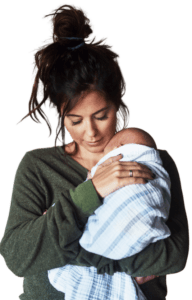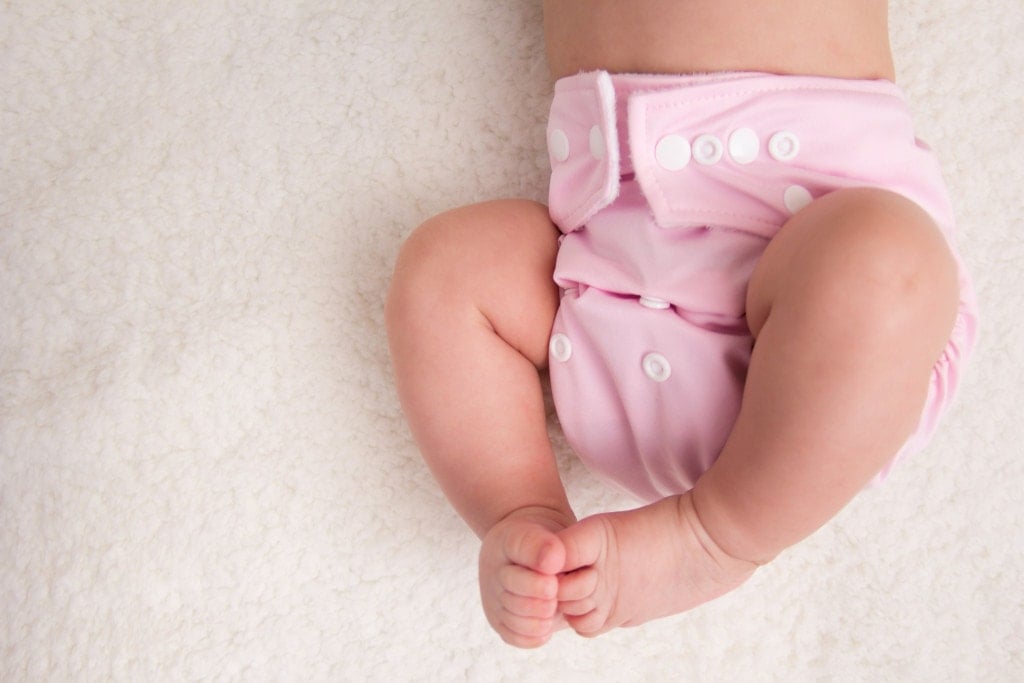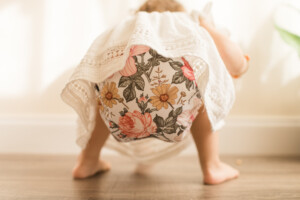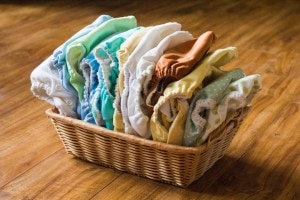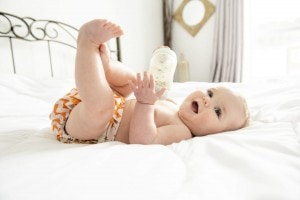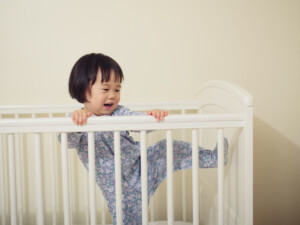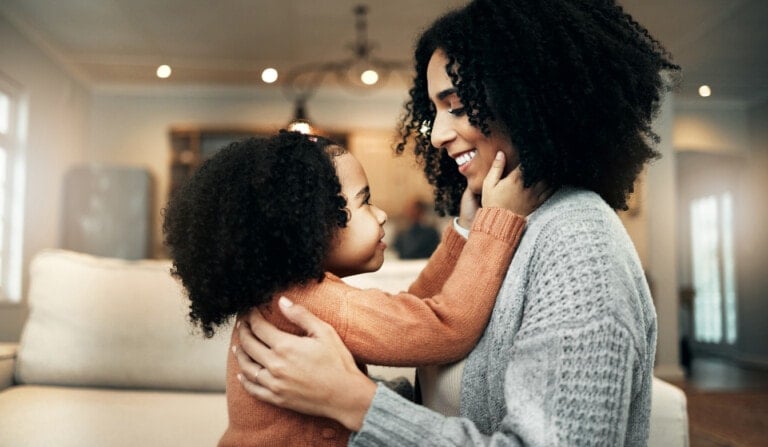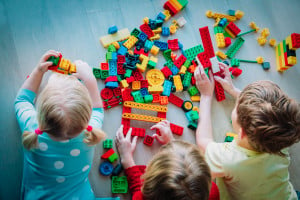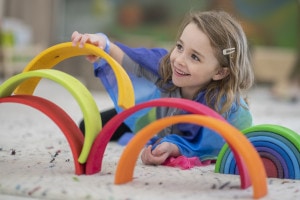Using cloth diapers can be an excellent option for your family. Not only do they offer natural fiber options and are adorable, but cloth diapers are also reusable and sustainable, making them a healthier choice for our planet. According to the Environmental Protection Agency, in 1980, 1,930 tons of disposable diapers were sent to landfills. By 2018, that number has risen to 4,100 tons. That’s 8,000,000 lbs of dirty diapers and just from the United States!1
Landfills are designed to be waterproof and airtight to prevent contamination of surrounding land. They were designed to STORE waste. Not break it down. Every disposable diaper that has ever been used is still pristine, likely looking exactly as it did the day it was put there.
I share this as an encouragement that small changes can have a big impact. Even a single diaper change with a cloth diaper keeps one disposable diaper out of a landfill. Using cloth diapers, even part-time, makes an impact.
Getting Started with Cloth Diapering
You just brought a tiny human into the world. Parenting can be confusing and overwhelming as it is. The diapers you choose shouldn’t add frustration. Keep it simple!
To successfully cloth diaper, you only need the cloth diapers and a place to store them once they are dirty. My #1 advice for getting started with cloth diapers is don’t stock up on all one brand or style before you’ve had a chance to use some. No cloth diaper will work on every baby, and you will discover there are things you like and dislike. It’s better to grab a small variety of cloth diapers at first. A few different brands. And a few different styles. Then when the baby comes, you can use them and experiment. Keep what you love and either sell or donate the ones that didn’t work out.
Where to Buy Cloth Diapers and Cloth Diaper Accessories
I will always encourage shopping locally and give small online businesses a chance. They put their whole hearts into what they do, and it shows.
Local Brick and Mortar Stores
While I wish more places carried cloth diapers in-store, I am still grateful that specialty baby boutiques and natural grocers have them. This allows you to touch and feel the product before buying.
I highly encourage you to shop from businesses like that. They stand behind what they sell. You can ask questions in real-time and get answers from a knowledgeable professional. And often, the customer service and experience will be top-notch.
Online Retailers
And again, I’m going to encourage you to shop small online boutiques for natural products and cloth diapers. The reason is not surprising. They, too, have carefully vetted the products they carry. You will find a knowledgeable owner and staff. They will know their cloth diapers inside and out and will happily answer your questions. They also offer excellent customer incentives. Many offer free or low-cost shipping options, rewards programs (may help you earn MORE cloth diapers), gifts with purchase, and either layaway or similar payment options (i.e., Sezzle, Afterpay, or Pay in 4).
Something else that is unique and awesome is cloth diaper retailers sometimes offer cloth diaper rentals or 30-day use and return policies. You won’t find this kind of program online on Amazon or big-box retailers. A rental allows you to try cloth diapers without an upfront commitment. Do some research, see which cloth diapering program works best for you, and then receive them in the mail (often with any accessories you may need to get started). You can sometimes try the cloth diapers for a month or longer. See what works and what doesn’t. And THEN commit and buy what you know already works for you.
A 30-day trial is a bit different but still has the same purpose. They allow you, as a customer, to buy something new and see if it works for your baby and your family. If you don’t like the diaper style or it just doesn’t work out for the baby, within that first month, you can send it back for a refund or exchange it for something else (depending on the store’s policies).
No matter where you choose to shop online, always do a little research before your first purchase. Look at their social media pages, look around their website, and look for reviews from other customers. Try to shop with reputable retailers with good reputations for backing their products and for outstanding customer service. It will help save you any headaches from happening later.
Buy Preloved
You can find preloved cloth diapers locally on For Sale boards, Facebook’s Marketplace, and Craig’s List. Otherwise, try general used cloth diaper sales groups and brand-specific pages on Facebook. Mercari and eBay are also great places to look, and the diapers can be shipped to you.
Suppose you are open to the idea of using preloved cloth diapers. In that case, you’ll find an amazing opportunity to save money and help maintain the sustainable purpose of cloth diapers in the first place. The more use something gets before it gets retired to a landfill, the better it is for the planet and all of us who call it home.
Please know that you can safely purchase and use previously used cloth diapers. They need to be in good working order, including elastics that aren’t stretched out and good closures (snap or hook and loop). You can safely disinfect cloth diapers, so nothing is passed between children. And if you want to give them a good cleaning because you don’t know where they came from, there’s no harm in that either.
I advise you only to take this path if you already know what to look for when buying used cloth diapers. As with anything unfamiliar, it’s easy to end up with something you wish you hadn’t bought.
How Many Cloth Diapers Do You Need?
All it takes to start cloth diapering is ONE cloth diaper. Touching that one diaper lets you see how simple cloth diapering is. That it may not be overwhelming as you thought. That you CAN do this.
Realistically, if you want to cloth diaper full time at the newborn stage, you’ll need about 20-24 cloth diapers to go two full days. That number goes down as children get older. You’ll only need half that by toddlerhood (16 months and older). Older children tend to go less and often sleep through the night, which means only 1 diaper for those 12 hours.
Cloth Diaper Styles
You’ll find there are many brands and styles to choose from. This is great because you can get exactly what you want and something that works great. However, it can be overwhelming. Here’s a brief description of the most common styles.
All-in-One Cloth Diaper
Super easy to use. As close to a disposable as you’ll get. The absorbent inner is attached to the waterproof outer. Everything is in one piece. No matching inserts or stuffing is required. You put it on. Take it off. Wash. And repeat. These are also an excellent option for daycare and caregivers as they offer the most convenience and ease of use.
All-in-Two Cloth Diapers
These are also pretty high on the easy-to-use scale. There is a bit more work to put them together; however, a benefit is you can customize the absorbency easily, and they are typically very trim fitting. All-in-Twos feature two separate pieces: the absorbent insert, which typically snaps in the cover, and the waterproof cover.
Pocket Cloth Diapers
This is an affordable option that is popular with cloth diapering families. They are like All-in-Twos in the way they have a separate absorbent insert and outer waterproof cover. Instead of snapping in or laying down an insert, you stuff it inside an attached pocket. You can customize absorbency and have a stay-dry layer (created by the pocket) between your baby and the soiled diaper. Pocket diapers aren’t wildly bulky but aren’t the trimmest option available.
Fitteds, Prefolds, & Flats
While each is popular with their crowds, they require different skill levels and provide different conveniences. All require an additional waterproof outer layer. Fitteds often have snap closures but may require an additional closure, such as a snappi or pin. They are usually more expensive, a little bulky, and very absorbent. Many use them for night diapers because of that.
Prefolds are made of several layers of fabric sewn together. They are very affordable and versatile. You need to fold them for use, but that might be as simple as folding them into a pad fold and laying it in a cover as you would an insert. Otherwise, you can attach it to the baby like a fitted with a closure like a snappi or a pin.
Flats are hands down the easiest cloth diaper to wash and dry. And depending on the fabric content, it is also the most affordable. Flats are made of a single layer of fabric. Because of that, it must be folded to be put on the baby. It’s a learned skill to figure out how to best fold it for your baby. But it pays off because flats are often a trim, absorbent option. You will need a separate, waterproof outer.
Dirty Diaper Storage Options
You’ll need a place to store dirty cloth diapers until wash day. There are two ways to do this. One way has air circulation involved, and the other doesn’t.
Closed options include waterproof wet bags or diaper pails with lids and a cloth liner. The wet bags can be closed with a zipper, drawstring, or buckle. I find a zippered wet bag is the easiest to use and does the best job containing any smells. A diaper pail is a container like a trash can with a washable waterproof lining and a lid.
You can also use the open pail method. It’s similar above, but you leave the container open. The idea is that the additional airflow will keep smells at bay.
In conclusion
You only NEED two things to cloth diaper: a cloth diaper and a place to store it while waiting for wash day. The many other cloth diaper-related products are just fun accessories. As with anything, convenience increases with the more bells and whistles you add. Just be sure to investigate a bit before making any purchases.
It may seem like there is so much you must know before you start, and if you don’t know it all, you will screw everything up. I was there once. And I felt that way too. I encourage you to follow that “keep it simple” principle when thinking about cloth diapering. They are not made of magical unicorn hair. There is little you can do that will ruin them. They are just diapers. Treat them as such.
I applaud you for considering cloth as an option. I know you can do this!
